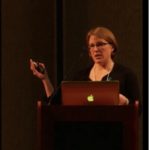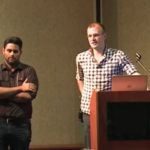Thomas Schulthess from CSCS gave this talk at the Blue Waters Summit. “Application performance is given much emphasis in discussions of exascale computing. A 50-fold increase in sustained performance over today’s applications running on multi-petaflops supercomputing platforms should be the expected target for exascale systems deployed early next decade. We will reflect on what this means in practice and how much these exascale systems will advance the state of the art.”
Computational Biophysics in the Petascale Computing Era
Dr. Rommie E. Amaro from UC San Diego gave this talk at the Blue Waters Symposium. “In this talk I will discuss how the BlueWaters Petascale computing architecture forever altered the landscape and potential of computational biophysics. In particular, new and emerging capabilities for multiscale dynamic simulations that cross spatial scales from the molecular (angstrom) to cellular ultrastructure (near micron), and temporal scales from the picoseconds of macromolecular dynamics to the physiologically important time scales of organelles and cells (milliseconds to seconds) are now possible.”
Tutorial: “How to use Jupyter Notebooks”
In this video from the Blue Waters Symposium, Roland Haas from NCSA presents: Tutorial: How to use Jupyter Notebooks. “Jupyter notebooks provide a web-based interface to Python, R, Julia and other languages. They allow code, code output, and documentation to be mixed in a single document making it possible to contain self-documented workflows. Focusing on Python I will show how to use Jupyter notebooks on Blue Waters to explore data, produce plots and analyze simulation output using numpy, matplotlib and time permitting, I will show how to use notebooks on login nodes and on compute nodes as well as, time permitting, how to use parallelism inside of Jupyter notebooks.”
Advances in the Fields of Atmospheric Science, Climate, and Weather
Susan Bates from NCAR gave this talk at the Blue Waters Summit. “For the past five years, the Blue Waters Project has provided an invaluable platform for research in the fields of atmospheric science, climate, and weather. The computationally intensive numerical models running on Blue Waters push the limits of model resolution and/or capability in first-of-their-kind simulations.”
Containers: Shifter and Singularity on Blue Waters
In this video from the Blue Waters 2018 Symposium, Maxim Belkin presents a tutorial on Containers: Shifter and Singularity on Blue Waters. “Container solutions are a great way to seamlessly execute code on a variety of platforms. Not only they are used to abstract away from the software stack of the underlying operating system, they also enable reproducible computational research. In this mini-tutorial, I will review the process of working with Shifter and Singularity on Blue Waters.”
Video: Massive Galaxies and Black Holes at the Cosmic Dawn
Tiziana DiMatteo from Carnegie Melon University gave this talk at the 2018 Blue Waters Symposium. “The first billion years is a pivotal time for cosmic structure formation. The galaxies and black holes that form then shape and influence all future generations of stars and black holes. Understanding and detecting the the first galaxies and black holes is therefore one of the main observational and theoretical challenges in galaxy formation.”
Machine Learning with Python: Distributed Training and Data Resources on Blue Waters
Aaron Saxton from NCSA gave this talk at the Blue Waters Symposium. “Blue Waters currently supports TensorFlow 1.3, PyTorch 0.3.0 and we hope to support CNTK and Horovod in the near future. This tutorial will go over the minimum ingredients needed to do distributed training on Blue Waters with these packages. What’s more, we also maintain an ImageNet data set to help researchers get started training CNN models. I will review the process by which a user can get access to this data set.”
Simulating the Earliest Generations of Galaxies with Enzo and Blue Waters
“Galaxies are complex—many physical processes operate simultaneously, and over a huge range of scales in space and time. As a result, accurately modeling the formation and evolution of galaxies over the lifetime of the universe presents tremendous technical challenges. In this talk I will describe some of the important unanswered questions regarding galaxy formation, discuss in general terms how we simulate the formation of galaxies on a computer, and present simulations (and accompanying published results) that the Enzo collaboration has recently done on the Blue Waters supercomputer. In particular, I will focus on the transition from metal-free to metal-enriched star formation in the universe, as well as the luminosity function of the earliest generations of galaxies and how we might observe it with the upcoming James Webb Space Telescope.”
Extreme-scale Graph Analysis on Blue Waters
George Slota presented this talk at the Blue Waters Symposium. “In recent years, many graph processing frameworks have been introduced with the goal to simplify analysis of real-world graphs on commodity hardware. However, these popular frameworks lack scalability to modern massive-scale datasets. This work introduces a methodology for graph processing on distributed HPC systems that is simple to implement, generalizable to broad classes of graph algorithms, and scales to systems with hundreds of thousands of cores and graphs of billions of vertices and trillions of edges.”
Tutorial: GPU Performance Nuggets
In this video from the 2016 Blue Waters Symposium, GPU Performance Nuggets – Carl Pearson and Simon Garcia De Gonzalo from the University of Illinois present: GPU Performance Nuggets. “In this talk, we introduce a pair of Nvidia performance tools available on Blue Waters. We discuss what the GPU memory hierarchy provides for your application. We then present a case study that explores if memory hierarchy optimization can go too far.”













